Lenovo IdeaPad 5 Pro (16″, AMD) review – a thin and light laptop for gaming and content creation
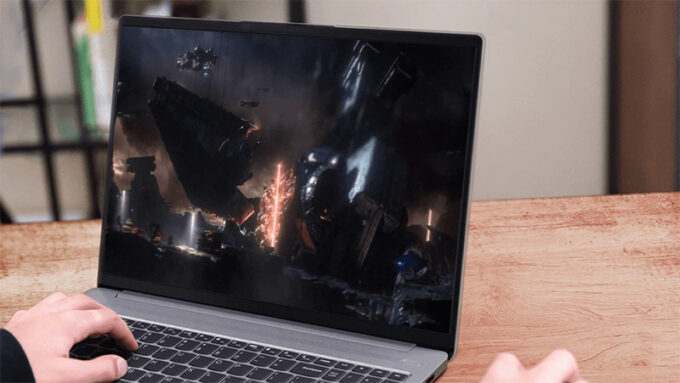 Lenovo took the market by storm when it announced the 16-inch Pro Legion and IdeaPad devices. And while the Legion 5 Pro 16″ happened to be the sweet spot for gamers, the IdeaPad 5 Pro (16″) might just be the same, but for content creation. Obviously, it sports a 16-inch IPS panel, and there are two options – one with a 60Hz, and one with a 120Hz refresh rate. Additionally, it sports a 16:10 aspect ratio and 2560×1600 resolution, which is pretty sharp.
Lenovo took the market by storm when it announced the 16-inch Pro Legion and IdeaPad devices. And while the Legion 5 Pro 16″ happened to be the sweet spot for gamers, the IdeaPad 5 Pro (16″) might just be the same, but for content creation. Obviously, it sports a 16-inch IPS panel, and there are two options – one with a 60Hz, and one with a 120Hz refresh rate. Additionally, it sports a 16:10 aspect ratio and 2560×1600 resolution, which is pretty sharp.
However, what is arguably more intriguing is what is under the bonnet. The AMD version of this laptop sports up to a Ryzen 9 5900HX – yes, the 45W flagship processor of team Red on the mobile market. In addition, you can pair the device with the GeForce RTX 3050. It has a lowly 35W TGP, but Dynamic Boost is here to push it up to a maximum of 55W. Spoiler alert – our device was able to match it.
One would ask what is so special about that – this isn’t the first notebook to feature these specs, and it is definitely not the most powerful one out there. Well, ladies and gentlemen, this all happens in a body that is 18.4mm at its thickest and weighs only 1.9 kilos. Looks pretty special to us.
You can check the prices and configurations in our Specs System: https://laptopmedia.com/series/lenovo-ideapad-5-pro-16/
Contents
Specs Sheet
- HDD/SSD
- up to 2000GB SSD
- M.2 Slot
- 1x 2280 M.2 NVMe slot See photo
- RAM
- up to 16GB
- OS
- Windows 11 Home, Windows 11 Pro, Windows 10 Home, Windows 10 Pro, No OS
- Battery
- 75Wh, 4-cell
- Body material
- Aluminum
- Dimensions
- 356 x 251 x 16.9 ~ 18.4 mm (14.02" x 9.88" x 0.67")
- Weight
- 1.90 kg (4.2 lbs)
- Ports and connectivity
- 2x USB Type-A
- 3.2 Gen 1 (5 Gbps)
- 1x USB Type-C
- 3.2 Gen 2 (10 Gbps), Power Delivery (PD), DisplayPort
- HDMI
- 1.4b
- Card reader
- MMC, SD, SDHC, SDXC
- Ethernet LAN
- Wi-Fi
- 802.11ax
- Bluetooth
- 5.1
- Audio jack
- 3.5mm Combo Jack
- Features
- Fingerprint reader
- optional
- Web camera
- HD
- Backlit keyboard
- optional
- Microphone
- Dual Array Microphone
- Speakers
- 2x 2W, Dolby Atmos
- Optical drive
All Lenovo IdeaPad 5 Pro (16″, 2021) configurations
What’s in the box?
Inside the package, Lenovo supplies some paper manuals and a 135W charger.
Design and construction
The aforementioned weight and thickness are achieved with a body and lid made out of aluminum. Even though the IdeaPad 5 Pro (16″) is pretty thin, it is super rigid, with almost no flex in either the lid or the base. This is pretty respectable in our view.
Perhaps the most satisfying feature of this machine is the hinge mechanism. The two hinges are placed pretty far away from each other, which provides extra stability. Additionally, the lid opens easily with a single hand, while the motion is fluid. Furthermore, the matte panel is surrounded by very thin bezels. And to accommodate the 720p camera and the IR face recognition hardware, Lenovo gave this laptop a notch. But it is nothing like the abomination found on the new MacBook Pros. Instead, it protrudes upwards, doubling as a handle when you open the device.
Next comes the base. Here, you won’t find a fingerprint reader, but on the bright side, the power button is separated from the keyboard deck. Also, the keycaps look pretty large (including the Arrow keys), and there is a NumberPad to play with. On the other hand, the key travel is a bit shallow, albeit the feedback is clicky.
Another thing with shallow key travel is the touchpad. In fact, it almost feels like Apple’s haptics on their Trackpads. Thankfully though, the Mylar surface on the touchpad offers a smooth gliding experience, while the tracking is also pretty accurate.
Looking at the bottom panel reveals the speaker cutouts, as well as the rather large ventilation grill. Respectively, the hot air gets exhausted from two vents in between the lid, and the base, which are essentially firing towards the bottom of the screen.
Ports
On the left side, there is the power plug, an HDMI 1.4b connector, a USB Type-C 3.2 (Gen. 2) port, and an audio jack. Then, on the right, you will find two USB Type-A 3.2 (Gen. 1) ports and a full-sized SD card reader.
Disassembly, upgrade options and maintenance
To take this laptop apart, you need to undo 9 Torx-head screws. Then, pry the bottom panel with a plastic tool and lift it away.
The first thing we see inside is the battery. It has a capacity of 75Wh.
Unfortunately, all of the memory here is soldered to the motherboard. On the bright side, you can configure the device with up to 32GB of DDR4 RAM. In terms of storage, there is one M.2 PCIe x4 slot.
This notebook’s cooling setup features two heat pipes shared between the CPU and the GPU. Additionally, there are two heat sinks, and two fans, blowing the heat away from the chassis.
Display quality
Lenovo IdeaPad 5 Pro (16″) in the configuration we tested has a 60Hz WQXGA panel – LEN160WQXGA (LEN9150). Its diagonal is 16-inch (40.6 cm), and the resolution is 2560 х 1600 pixels. The screen ratio is 16:10, and we are looking at a pixel density of – 189 ppi, and a pitch of 0.13 х 0.13 mm. The screen turns into Retina when viewed at distance equal to or greater than 46cm (18″) (from this distance one’s eye stops differentiating the separate pixels, and it is normal for looking at a laptop).

Viewing angles are excellent. We offer images at 45° to evaluate image quality.

Also, a video with locked focus and exposure.
We measured a maximum brightness of 367 nits in the middle of the screen and 361 nits as an average for the whole area, with a maximum deviation of 9%. The Correlated Color Temperature on a white screen is 6700K – slightly colder than the optimal for the sRGB standard of 6500K.
In the illustration below you can see how the main display performs from a uniformity perspective. In other words, the leakage of light from the light source.
Values of dE2000 over 4.0 should not occur, and this parameter is one of the first you should check if you intend to use the laptop for color-sensitive work. The contrast ratio is very good – 1470:1.
To make sure we are on the same page, we would like to give you a little introduction to the sRGB color gamut and the Adobe RGB. To start, there’s the CIE 1976 Uniform Chromaticity Diagram that represents the visible specter of colors by the human eye, giving you a better perception of the color gamut coverage and the color accuracy.
Inside the black triangle, you will see the standard color gamut (sRGB) that is being used by millions of people on HDTV and on the web. As for the Adobe RGB, this is used in professional cameras, monitors, etc for printing. Basically, colors inside the black triangle are used by everyone and this is the essential part of the color quality and color accuracy of a mainstream notebook.
Still, we’ve included other color spaces like the famous DCI-P3 standard used by movie studios, as well as the digital UHD Rec.2020 standard. Rec.2020, however, is still a thing of the future and it’s difficult for today’s displays to cover that well. We’ve also included the so-called Michael Pointer gamut, or Pointer’s gamut, which represents the colors that naturally occur around us every day.
The yellow dotted line shows Lenovo IdeaPad 5 Pro (16″)’s color gamut coverage.
Its display covers 89% of the sRGB/ITU-R BT.709 (web/HDTV standard) in CIE1976.
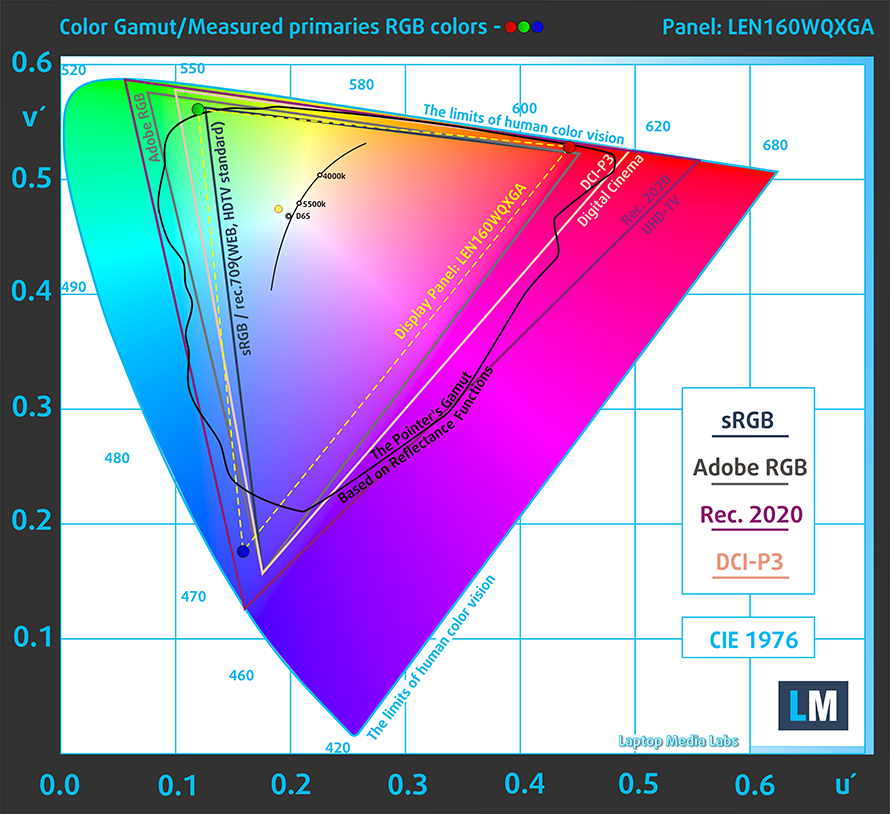
Our “Design and Gaming” profile delivers optimal color temperature (6500K) at 140 cd/m2 luminance and sRGB gamma mode.
We tested the accuracy of the display with 24 commonly used colors like light and dark human skin, blue sky, green grass, orange, etc. You can check out the results at factory condition and also, with the “Design and Gaming” profile.
Below you can compare the scores of Lenovo IdeaPad 5 Pro (16″) with the default settings (left), and with the “Gaming and Web design” profile (right).
The next figure shows how well the display is able to reproduce really dark parts of an image, which is essential when watching movies or playing games in low ambient light.
The left side of the image represents the display with stock settings, while the right one is with the “Gaming and Web Design” profile activated. On the horizontal axis, you will find the grayscale, and on the vertical axis – the luminance of the display. On the two graphs below you can easily check for yourself how your display handles the darkest nuances but keep in mind that this also depends on the settings of your current display, the calibration, the viewing angle, and the surrounding light conditions.
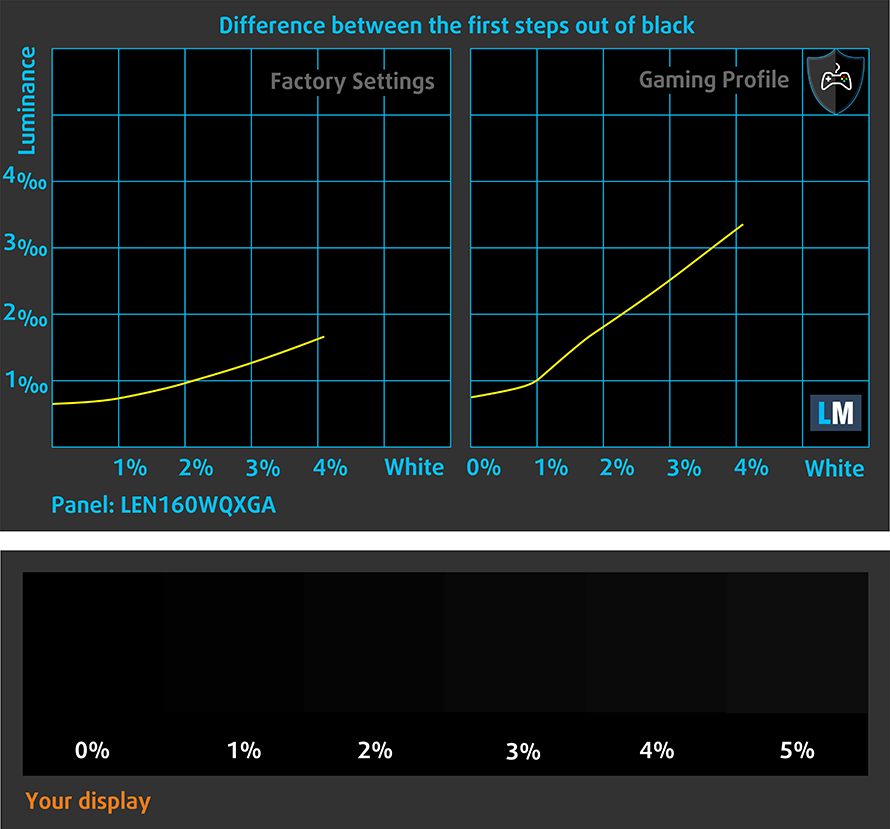
Response time (Gaming capabilities)
We test the reaction time of the pixels with the usual “black-to-white” and “white-to-black” method from 10% to 90% and vice versa.
We recorded Fall Time + Rise Time = 25 ms.
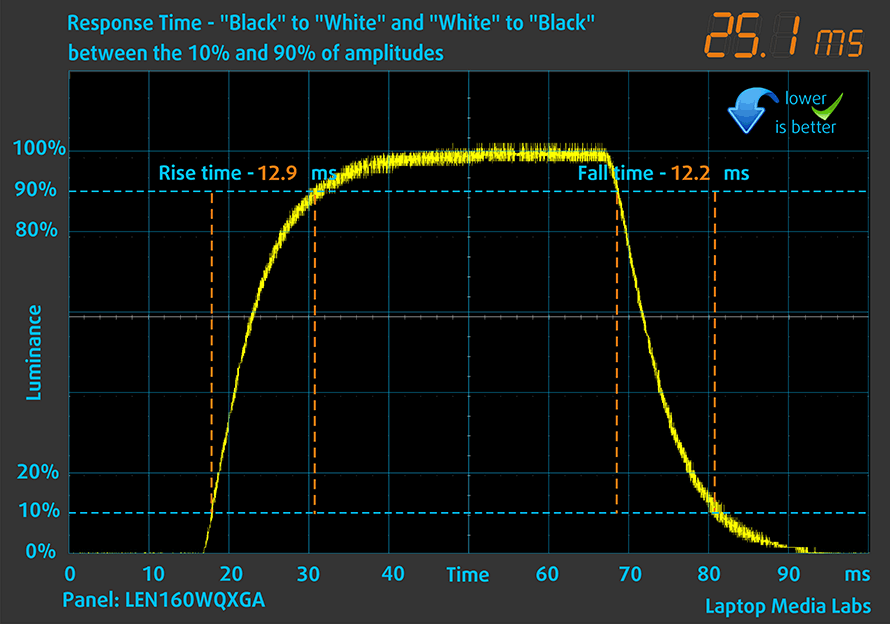
After that, we test the reaction time of the pixels with the usual “Gray-to-Gray” method from 50% White to 80% White and vice versa between 10% and 90% of the amplitude.
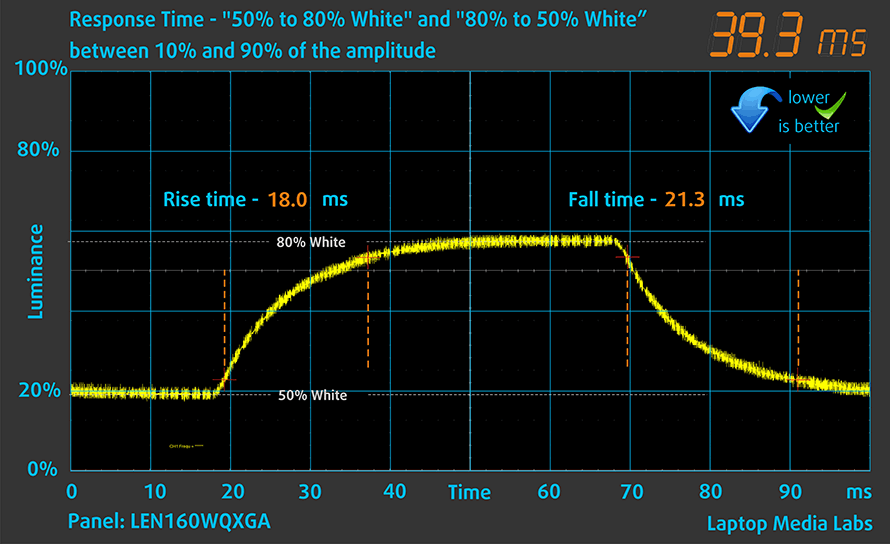
PWM (Screen flickering)
Pulse-width modulation (PWM) is an easy way to control monitor brightness. When you lower the brightness, the light intensity of the backlight is not lowered, but instead turned off and on by the electronics with a frequency indistinguishable to the human eye. In these light impulses, the light/no-light time ratio varies, while brightness remains unchanged, which is harmful to your eyes. You can read more about that in our dedicated article on PWM.
Lenovo IdeaPad 5 Pro (16″)’s display doesn’t use PWM to adjust its brightness at any point. This means it is comfortable for long gaming sessions without harming your eyes in this aspect.
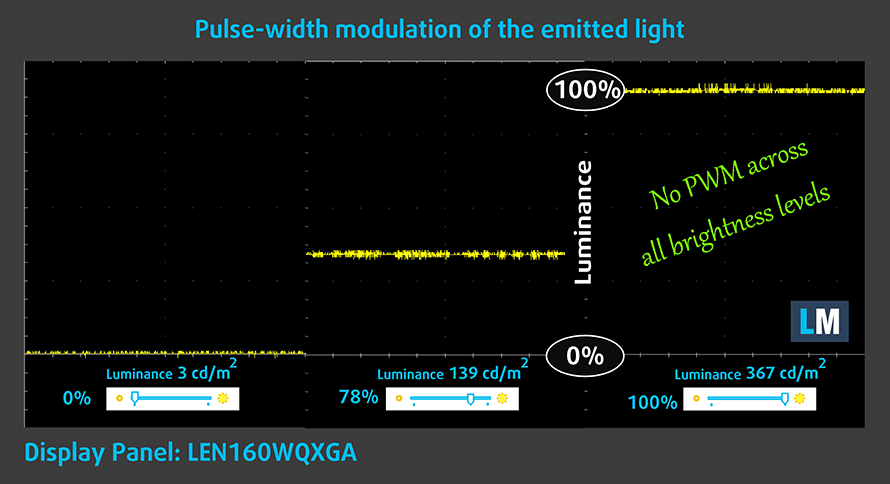
Blue light emissions
Installing our Health-Guard profile not only eliminates PWM but also reduces the harmful Blue Light emissions while keeping the colors of the screen perceptually accurate. If you’re not familiar with the Blue light, the TL;DR version is – emissions that negatively affect your eyes, skin, and your whole body. You can find more information about that in our dedicated article on Blue Light.
Buy our profiles
Since our profiles are tailored for each individual display model, this article and its respective profile package are meant for Lenovo IdeaPad 5 Pro (16″) configurations with 16″ WQXGA IPS LEN160WQXGA (LEN9150).
*Should you have problems with downloading the purchased file, try using a different browser to open the link you’ll receive via e-mail. If the download target is a .php file instead of an archive, change the file extension to .zip or contact us at [email protected].
Read more about the profiles HERE.
In addition to receiving efficient and health-friendly profiles, by buying LaptopMedia's products you also support the development of our labs, where we test devices in order to produce the most objective reviews possible.

Office Work
Office Work should be used mostly by users who spend most of the time looking at pieces of text, tables or just surfing. This profile aims to deliver better distinctness and clarity by keeping a flat gamma curve (2.20), native color temperature and perceptually accurate colors.

Design and Gaming
This profile is aimed at designers who work with colors professionally, and for games and movies as well. Design and Gaming takes display panels to their limits, making them as accurate as possible in the sRGB IEC61966-2-1 standard for Web and HDTV, at white point D65.

Health-Guard
Health-Guard eliminates the harmful Pulse-Width Modulation (PWM) and reduces the negative Blue Light which affects our eyes and body. Since it’s custom tailored for every panel, it manages to keep the colors perceptually accurate. Health-Guard simulates paper so the pressure on the eyes is greatly reduced.
Get all 3 profiles with 33% discount
Sound
Lenovo IdeaPad 5 Pro (16″)’s speakers produce a sound of decent quality and support Dolby Atmos. The low, mid, and high frequencies are all clear of deviations.
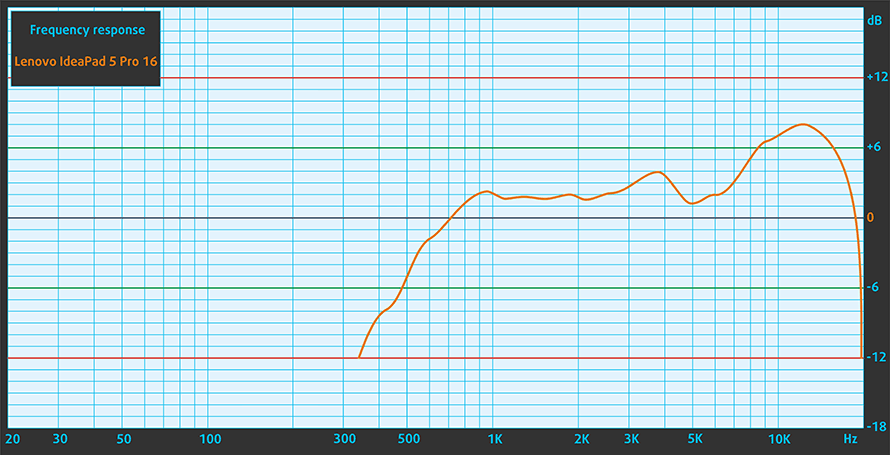
Drivers
All of the drivers and utilities for this notebook can be found here: https://pcsupport.lenovo.com/us/en/products/laptops-and-netbooks/5-series/ideapad-5-pro-16ach6/downloads/driver-list
Battery
Now, we conduct the battery tests with Windows Better performance setting turned on, screen brightness adjusted to 120 nits, and all other programs turned off except for the one we are testing the notebook with. This device’s 75Wh battery delivers 13 hours of Web browsing or nearly 9 hours of video playback.
In order to simulate real-life conditions, we used our own script for automatic web browsing through over 70 websites.
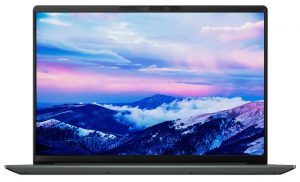
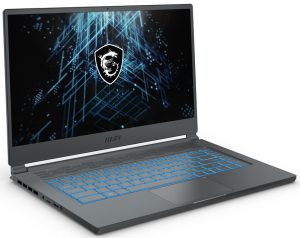
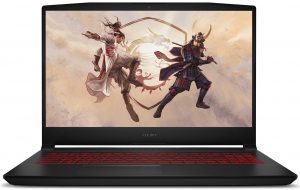
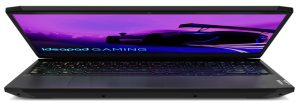
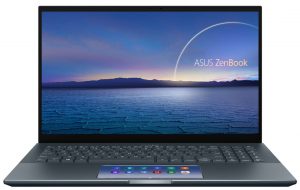
For every test like this, we use the same video in HD.





CPU options
The processor choices here include the Ryzen 5 5600H, Ryzen 7 5800H, and Ryzen 9 5900HX.
Results are from the Cinebench R23 CPU test (the higher the score, the better)
Results are from our Photoshop benchmark test (the lower the score, the better)
GPU options
GPU-wise, this laptop is offered in configurations with no dedicated GPU, and with a dedicated GPU in the face of the GTX 1650, or RTX 3050 (50W).
Results are from the 3DMark: Time Spy (Graphics) benchmark (higher the score, the better)
Results are from the 3DMark: Fire Strike (Graphics) benchmark (higher the score, the better)
Results are from the Unigine Superposition benchmark (higher the score, the better)
Gaming tests

| Far Cry 5 | Full HD, Normal (Check settings) | Full HD, High (Check settings) | Full HD, Ultra (Check settings) |
|---|---|---|---|
| Average fps | 78 fps | 72 fps | 67 fps |

| Rise of the Tomb Raider (2016) | Full HD, Lowest (Check settings) | Full HD, Medium (Check settings) | Full HD, Very High (Check settings) |
|---|---|---|---|
| Average fps | 125 fps | 95 fps | 50 fps |

| Shadow of the Tomb Raider (2018) | Full HD, Lowest (Check settings) | Full HD, Medium (Check settings) | Full HD, High (Check settings) |
|---|---|---|---|
| Average fps | 105 fps | 70 fps | 63 fps |

| Tom Clancy’s Ghost Recon Wildlands | Full HD, Medium (Check settings) | Full HD, High (Check settings) | Full HD, Very High (Check settings) |
|---|---|---|---|
| Average fps | 69 fps | 64 fps | 56 fps |
Temperatures and comfort
Max CPU load
In this test we use 100% on the CPU cores, monitoring their frequencies and chip temperature. The first column shows a computer’s reaction to a short load (2-10 seconds), the second column simulates a serious task (between 15 and 30 seconds), and the third column is a good indicator of how good the laptop is for long loads such as video rendering.
Average core frequency (base frequency + X); CPU temp.
| AMD Ryzen 7 5800H (45W TDP) | 0:02 – 0:10 sec | 0:15 – 0:30 sec | 10:00 – 15:00 min |
|---|---|---|---|
| Lenovo IdeaPad 5 Pro (16″) | 3.19 GHz @ 76°C | 3.07 GHz @ 79°C | 3.16 GHz @ 84°C |
| Dell G15 5515 | 3.29 GHz (B+3%) @ 74°C | 3.14 GHz @ 74°C | 3.21 GHz (B+0%) @ 82°C |
| HP Victus 16 (16-e0000) | 3.29 GHz (B+3%) @ 80°C | 3.20 GHz (B+0%) @ 80°C | 3.27 GHz (B+2%) @ 89°C |
| HP Omen 15 (2021, 15-en1000) | 3.33 GHz (B+4%) @ 78°C | 3.33 GHz (B+4%) @ 85°C | 3.42 GHz (B+7%) @ 88°C |
| ASUS ROG Strix SCAR 15 G533 | 3.43 GHz (B+7%) @ 76°C | 3.35 GHz (B+5%) @ 80°C | 3.47 GHz (B+8%) @ 82°C |
| ASUS ROG Zephyrus Duo 15 SE (GX551) | 3.93 GHz (B+23%) @ 81°C | 3.82 GHz (B+19%) @ 86°C | 3.78 GHz (B+18%) @ 93°C |
| ASUS TUF A17 (FA706) 2021 | 3.42 GHz (B+7%) @ 74°C | 3.34 GHz (B+4%) @ 78°C | 3.35 GHz (B+5%) @ 84°C |
Even with the Extreme performance preset enabled from BIOS, the laptop didn’t manage to run above the base clock speed of the Ryzen 7 5800H for long periods of time.
Real-life gaming
| NVIDIA GeForce RTX 3050 | GPU frequency/ Core temp (after 2 min) | GPU frequency/ Core temp (after 30 min) | GPU frequency/ Core temp (Max Fan) |
|---|---|---|---|
| Lenovo IdeaPad 5 Pro (16″) | 1651 MHz @ 72°C @ 55W | 1636 MHz @ 75°C @ 55W | – |
| HP Victus 16 (16-e0000) | 1824 MHz @ 73°C @ 75W | 1814 MHz @ 73°C @ 75W | 1822 MHz @ 73°C @ 75W |
| MSI Katana GF66 | 1675 MHz @ 73°C @ 60W | 1660 MHz @ 78°C @ 60W | 1699 MHz @ 67°C @ 60W |
On the other hand, the cooling solution is perfectly calculated for the 55W TGP of the RTX 3050 in this case.
Gaming comfort
Indeed, the laptop gets quite noisy during gaming. Also, the highest temperature we measured on the keyboard was 45°C. You can feel the heat, but it’s not too hot at the same time.
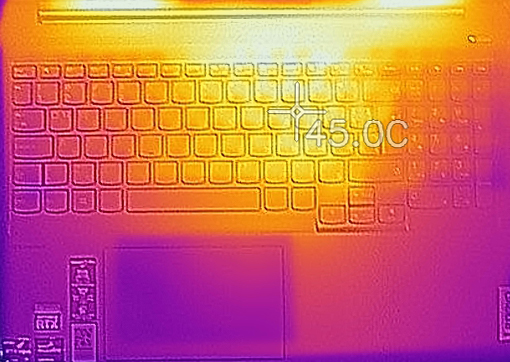
Verdict
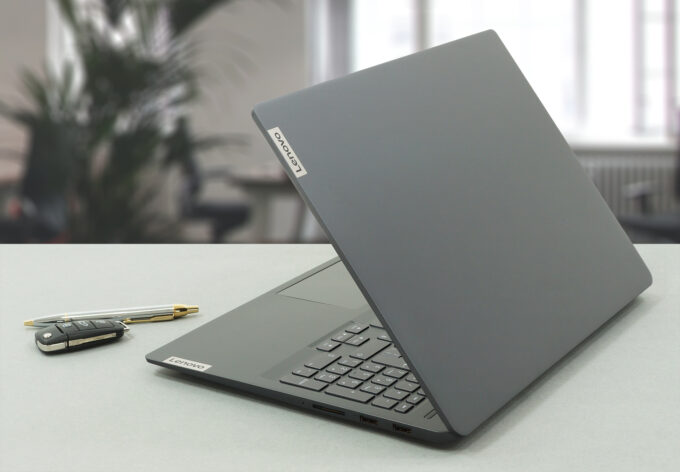 Before we start with the conclusion of this review, we want to say that Lenovo has once again made a logic-defying choice. It offers the IdeaPad 5 Pro (16″) with a 135W charging brick at best. At first glance, there is no issue with that. The laptop runs smoothly, and provides a decent performance output, although not fulfilling the potential of the Ryzen 7 5800H. However, if you plug your charger in, and you have anything less than 99% of juice in your battery, you won’t be able to max out your laptop.
Before we start with the conclusion of this review, we want to say that Lenovo has once again made a logic-defying choice. It offers the IdeaPad 5 Pro (16″) with a 135W charging brick at best. At first glance, there is no issue with that. The laptop runs smoothly, and provides a decent performance output, although not fulfilling the potential of the Ryzen 7 5800H. However, if you plug your charger in, and you have anything less than 99% of juice in your battery, you won’t be able to max out your laptop.
What happens is that once you apply a heavy load, the battery icon will show that you are plugging and unplugging the charger every two seconds. Obviously, we weren’t touching the cable whatsoever. It took us a while to realize that the charger doesn’t have the power to push the Ryzen 7 5800H and charge the battery at the same time. Interestingly, this is not the first time for Lenovo, as we experienced the opposite phenomenon with the IdeaPad Gaming 3i (15″, 2021). There, the battery level was dropping, when you played games, for the same reason – the charger was just not enough. Ultimately, the workaround here is not too tedious, as you just need to wait for the battery to charge to the maximum. Nevertheless, this doesn’t make it less annoying.
Other than that the battery life seems pretty decent on a 16-inch laptop with such a high-resolution display. We got about 13 hours of Web browsing or nearly 9 hours of video playback.
Lenovo IdeaPad 5 Pro (16″)’s 60Hz IPS display has a high resolution with a 16:10 aspect ratio, wide viewing angles, and a very good contrast ratio. Additionally, it doesn’t use PWM for brightness adjustment and covers 89% of the sRGB color gamut. Thankfully, our Gaming and Web design profile helps it reach a very low Average dE, which makes it usable for professional color-related work.
It is good to see that even though the laptop is pretty thin, Lenovo didn’t omit it from I/O, as you get two USB Type-A ports, an SD card reader, a USB Type-C 3.2 (Gen. 2) port, and an HDMI 1.4b connector. The last one is a bit unfortunate, as it means you are limited to 4K at only 30Hz unless you go for a USB Type-C connection.
Also, something that we find a bit disappointing is that the memory here is soldered to the motherboard. Thankfully, the maximum available configuration sports 32GB of dual-channel RAM and it is a DDR4 type that runs at 3200MHz, so you get the full bandwidth out of it.
All in all, this laptop is pretty decent for what it is. You shouldn’t expect to get the full performance out of the processor, as the cooling can’t cope with it, and you should definitely keep the charger shenanigans in mind. However, if you want something that looks good, runs fast, and will allow you to work with content or play your favorite game, the IdeaPad 5 Pro (16″) might be a viable choice.
You can check the prices and configurations in our Specs System: https://laptopmedia.com/series/lenovo-ideapad-5-pro-16/
Pros
- Thin and light outfit
- Strong aluminum chassis
- Covers 89% of the sRGB color gamut and has accurate color representation with our Gaming and Web design profile
- High resolution and 16:10 aspect ratio
- SD card slot
- Reasonable performance for its class
- IR face recognition
Cons
- Weird issue with the charger
- Slightly limited by cooling
- Soldered memory
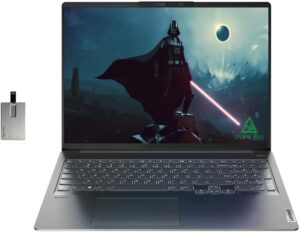
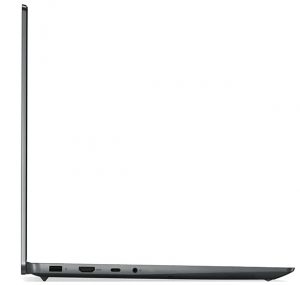
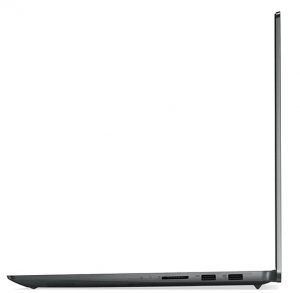
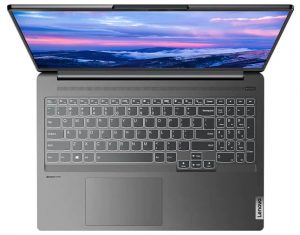
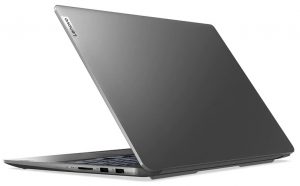
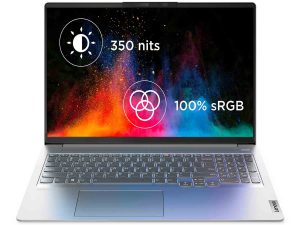
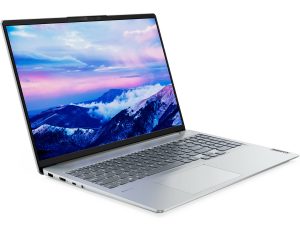
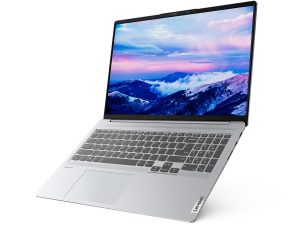
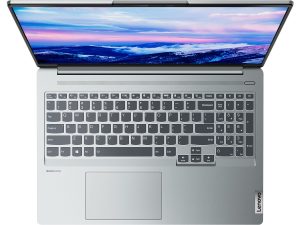
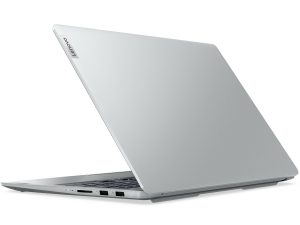
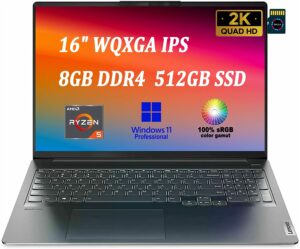

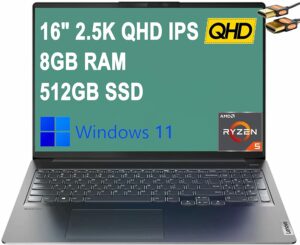
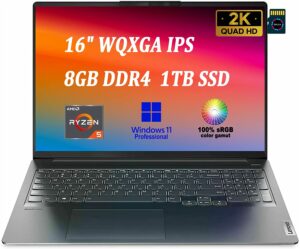
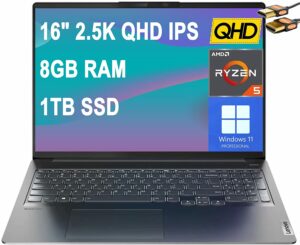
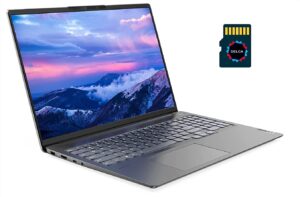
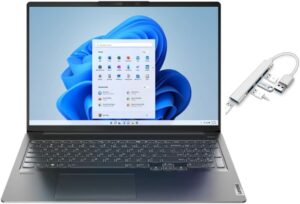
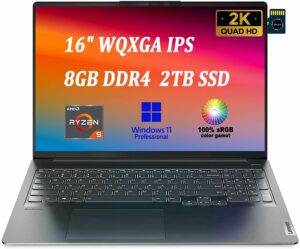
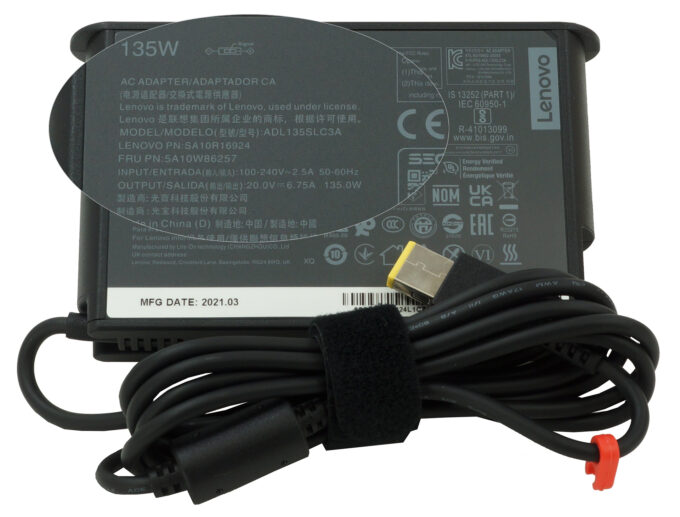
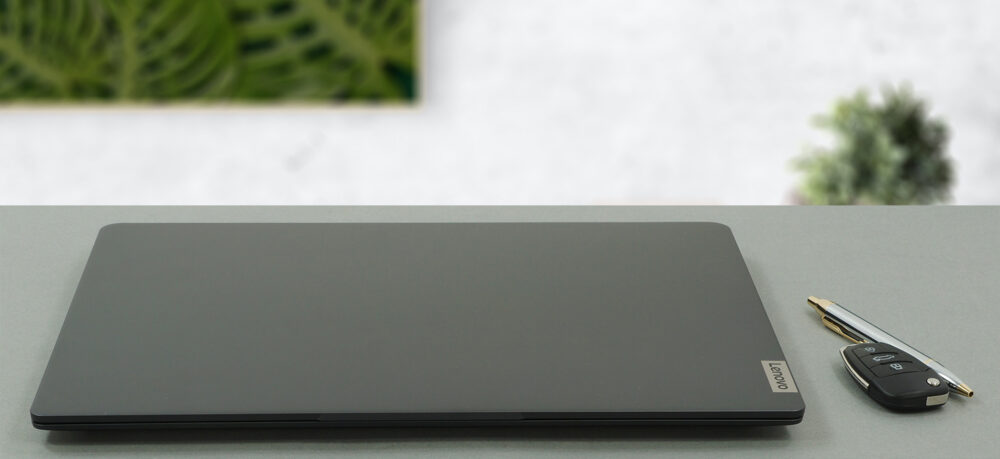
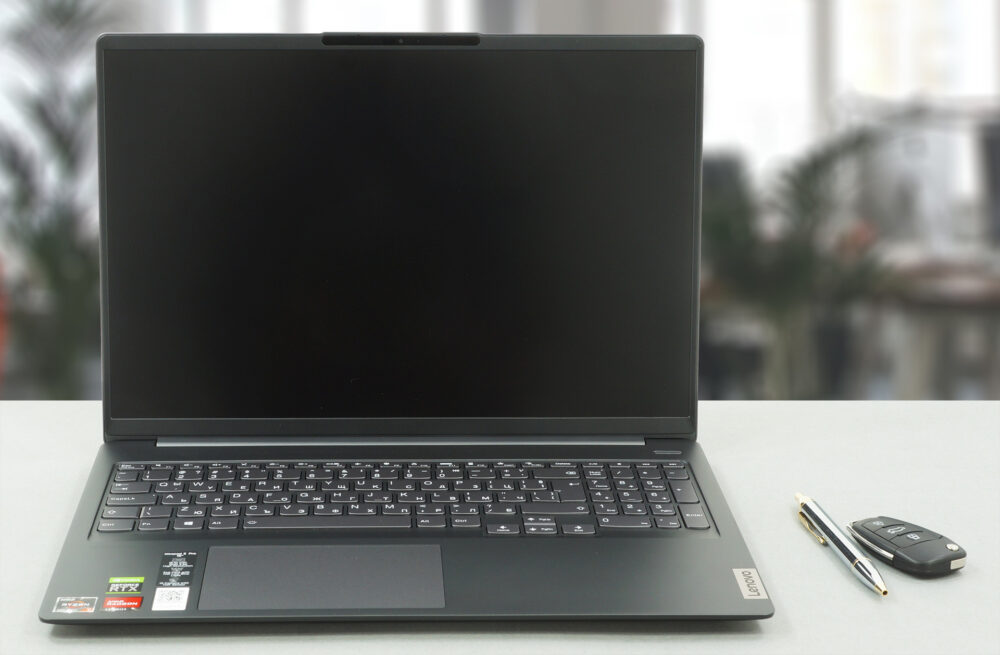
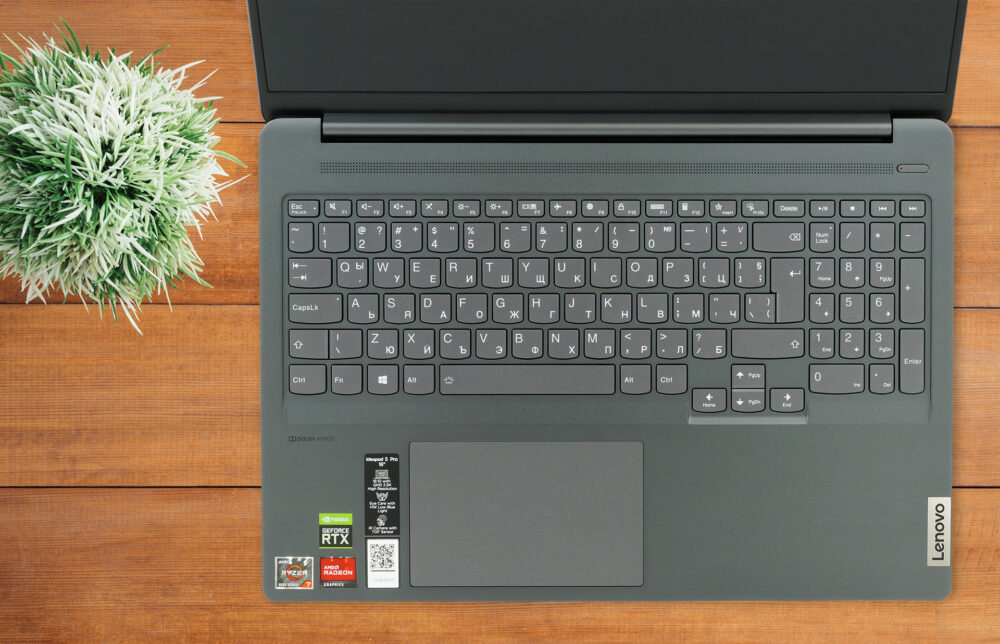
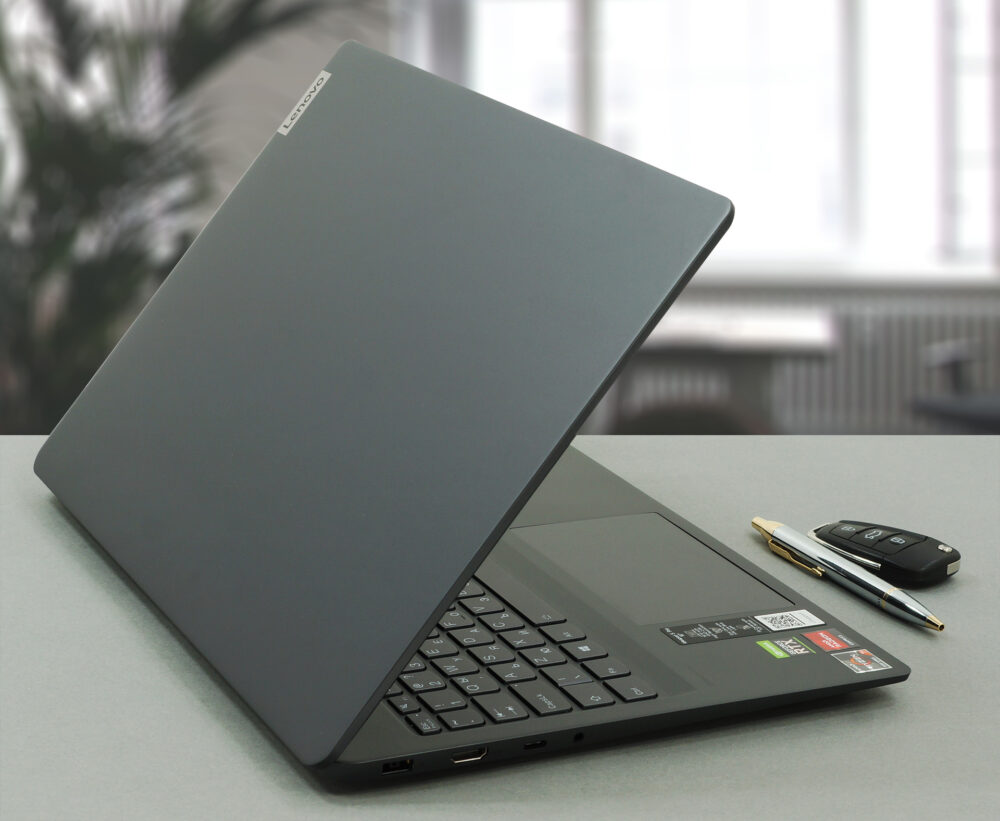
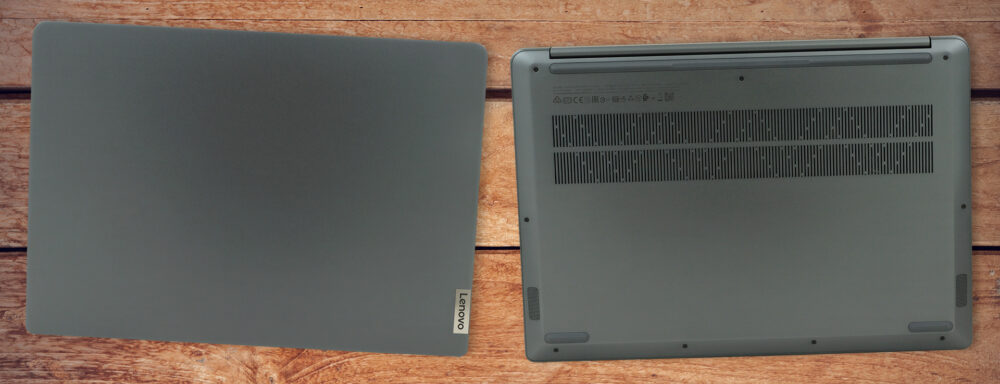


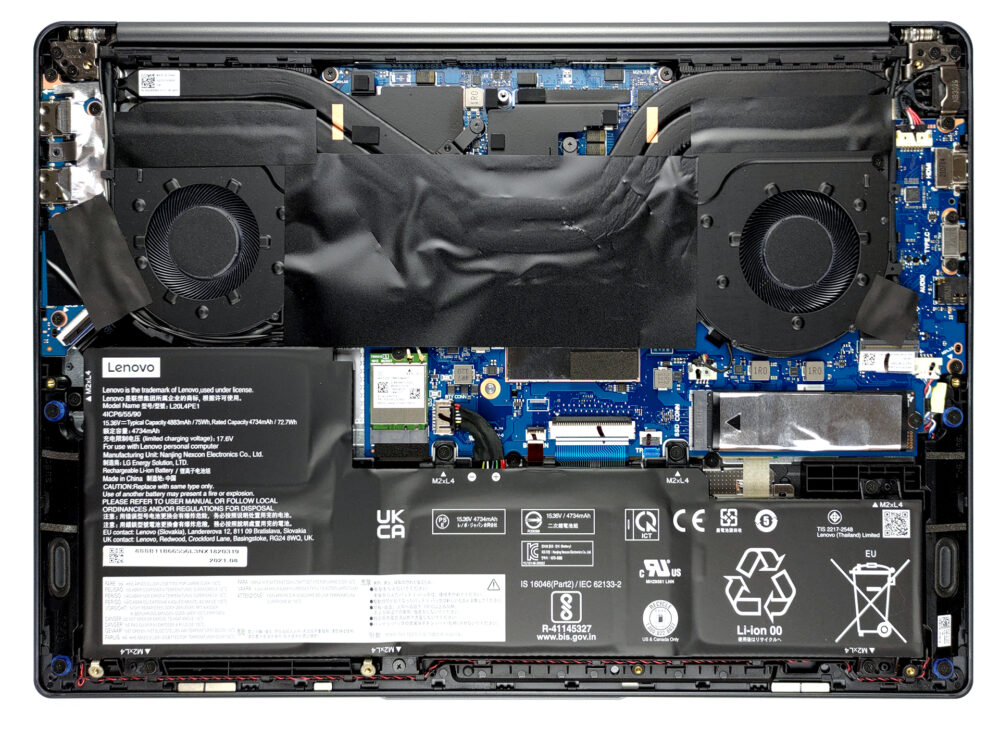
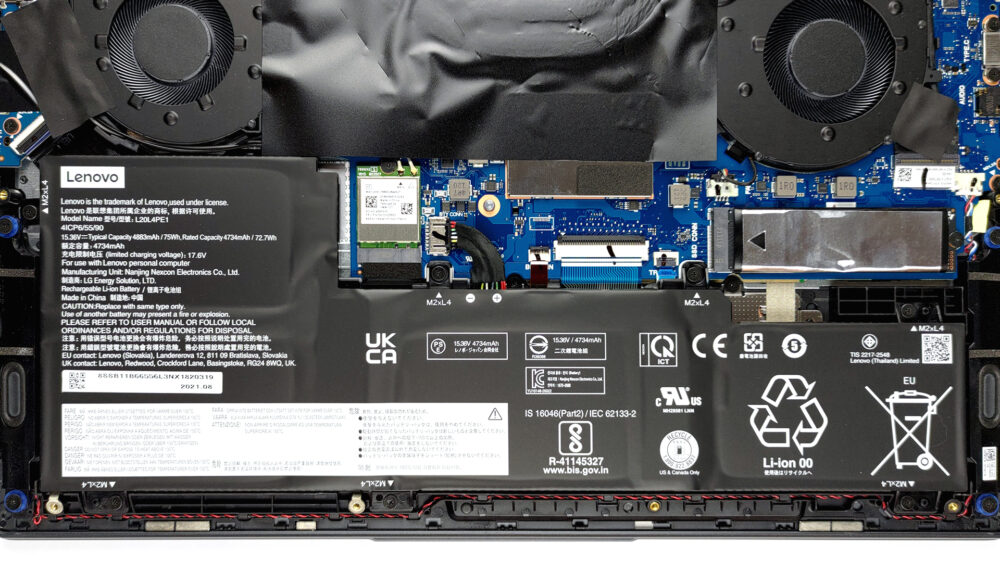
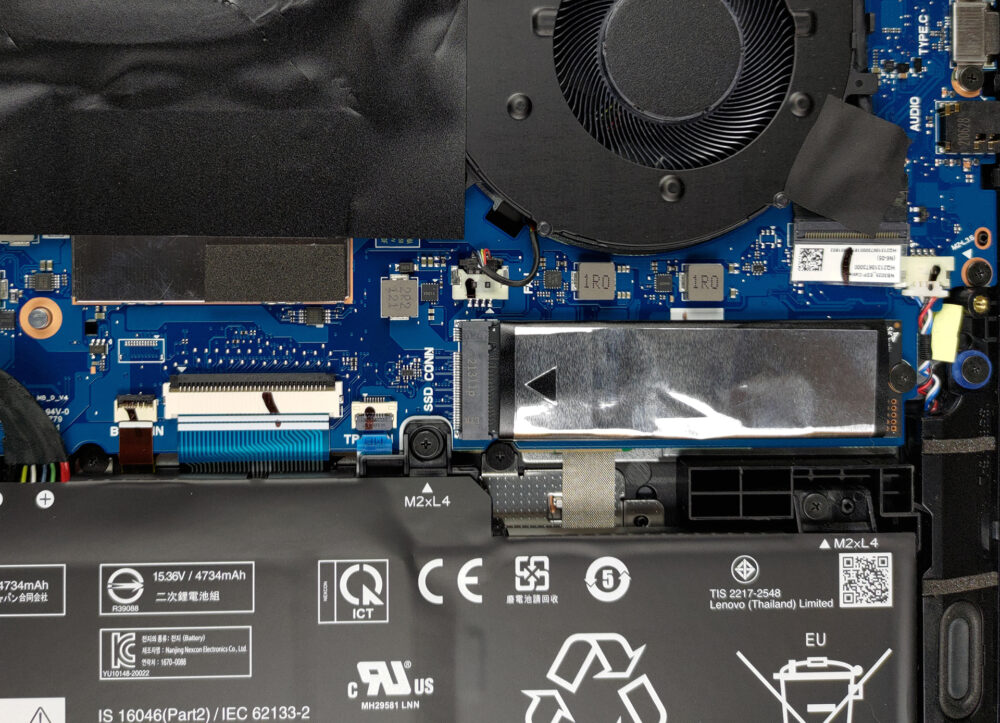
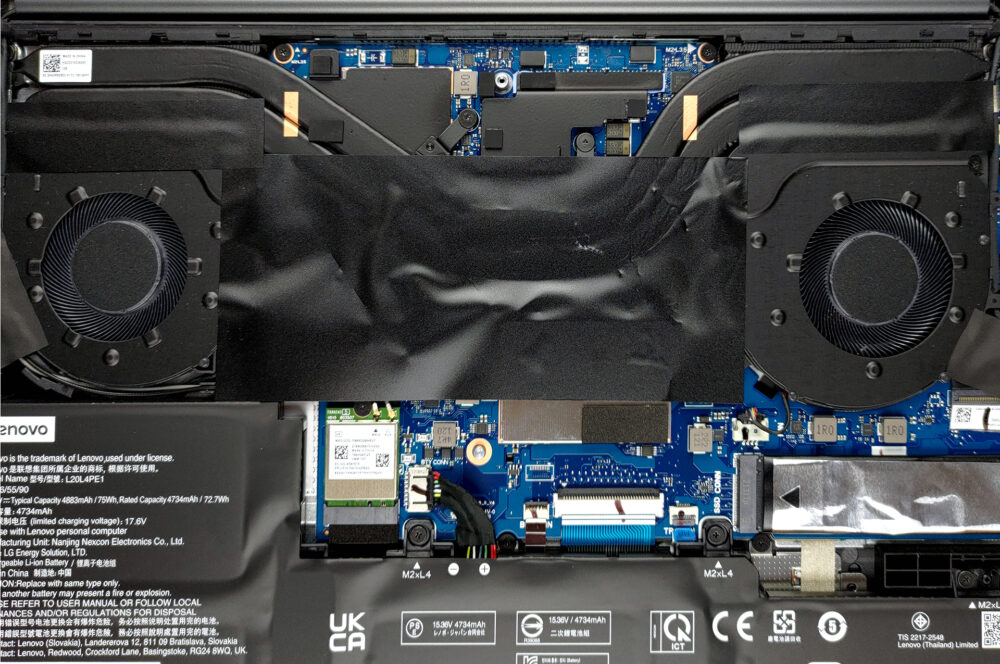
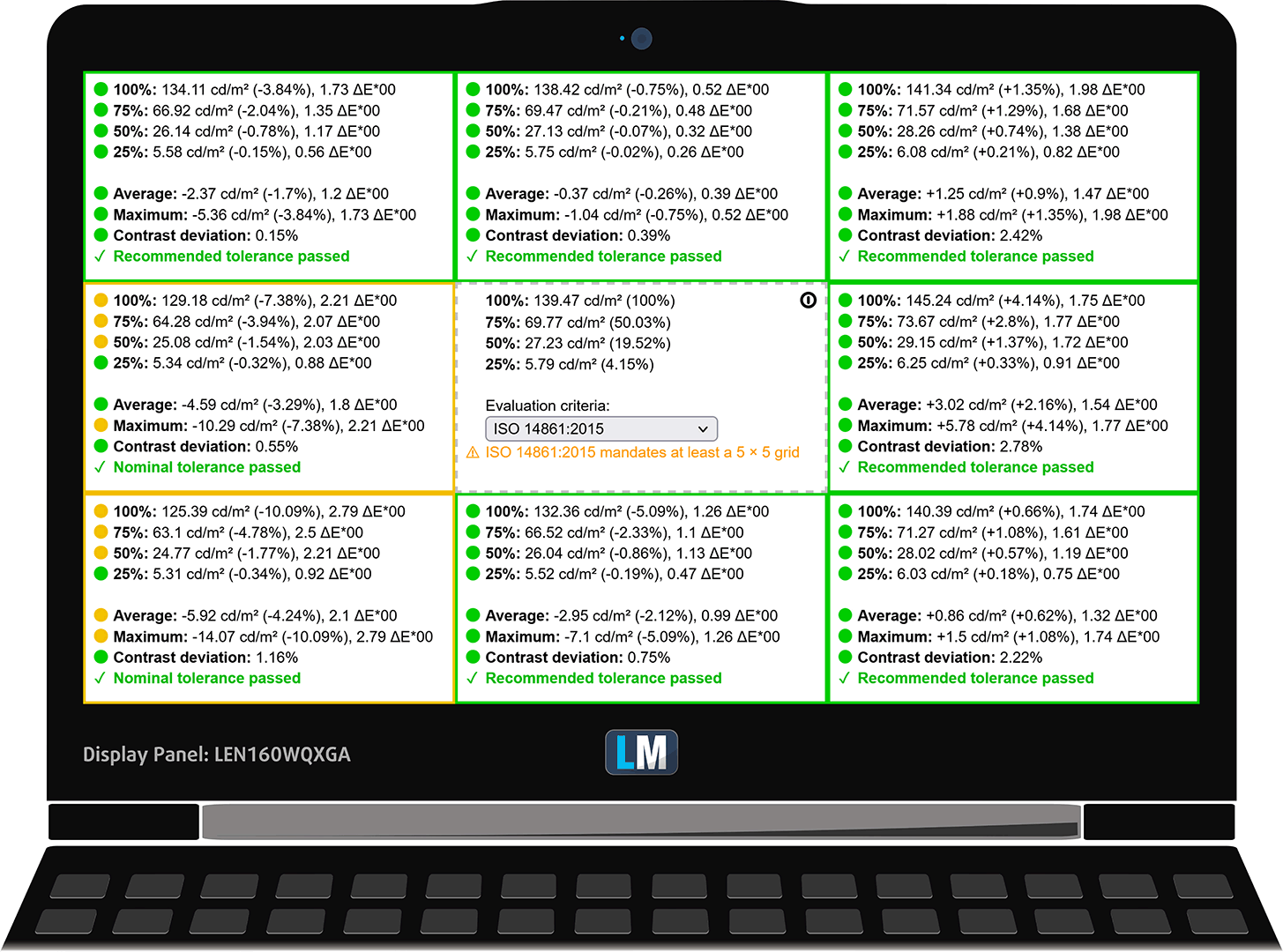



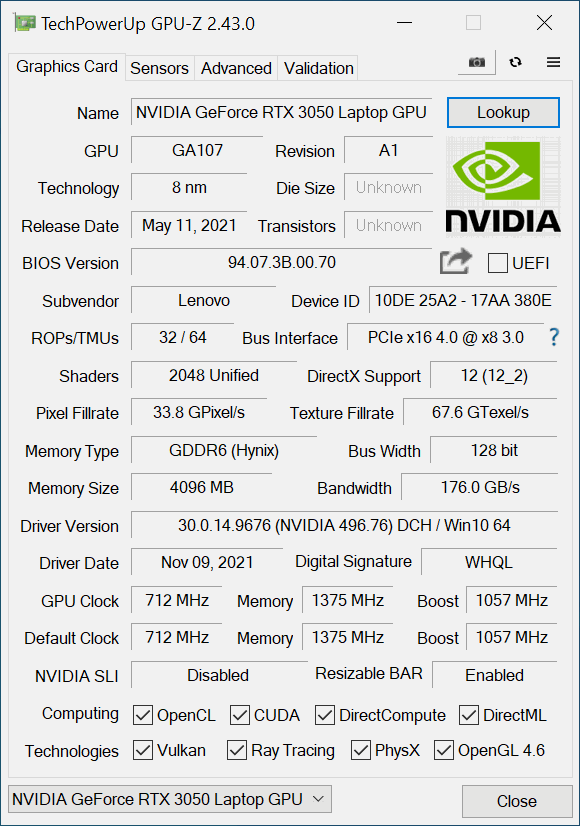








Have you or anyone who has this laptop made the USB-C docking function work? I have 2 monitors with USB-C docking and this laptop only says “your display connection might be limited” on both of them and doesn’t display anything at all. I even exchanged the laptop but the issue persists across Windows 10, Windows 11, different versions of AMD drivers etc. I even took it to Lenovo certified service center and they confirmed it doesn’t work with their hardware either.
The memory card reader is a “reader” not a “slot” that holds the card in place during transit. This was the most disappointing feature as soon as I unboxed mine. You should certainly put this on the “con” list not “pro” list.
Also, the review says this is a good gaming laptop, but it is specifically sold as a non-gaming laptop. I assume because of the issues you noted.
Quizás el autor probó la versión Ryzen 9 5900HX – GeForce RTX 3050, lo que permite a la máquina tener un buen desempeño para la mayoría de los juegos.